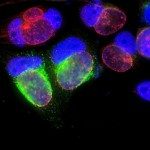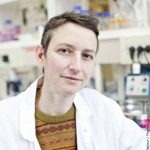Lien vers Pubmed [PMID] – 25069652
Mol. Biol. Evol. 2014 Nov;31(11):2890-904
Gene loss, gain, and transfer play an important role in shaping the genomes of all organisms; however, the interplay of these processes in isolated populations, such as in obligate intracellular bacteria, is less understood. Despite a general trend towards genome reduction in these microbes, our phylogenomic analysis of the phylum Chlamydiae revealed that within the family Parachlamydiaceae, gene family expansions have had pronounced effects on gene content. We discovered that the largest gene families within the phylum are the result of rapid gene birth-and-death evolution. These large gene families are comprised of members harboring eukaryotic-like ubiquitination-related domains, such as F-box and BTB-box domains, marking the largest reservoir of these proteins found among bacteria. A heterologous type III secretion system assay suggests that these proteins function as effectors manipulating the host cell. The large disparity in copy number of members in these families between closely related organisms suggests that nonadaptive processes might contribute to the evolution of these gene families. Gene birth-and-death evolution in concert with genomic drift might represent a previously undescribed mechanism by which isolated bacterial populations diversify.

